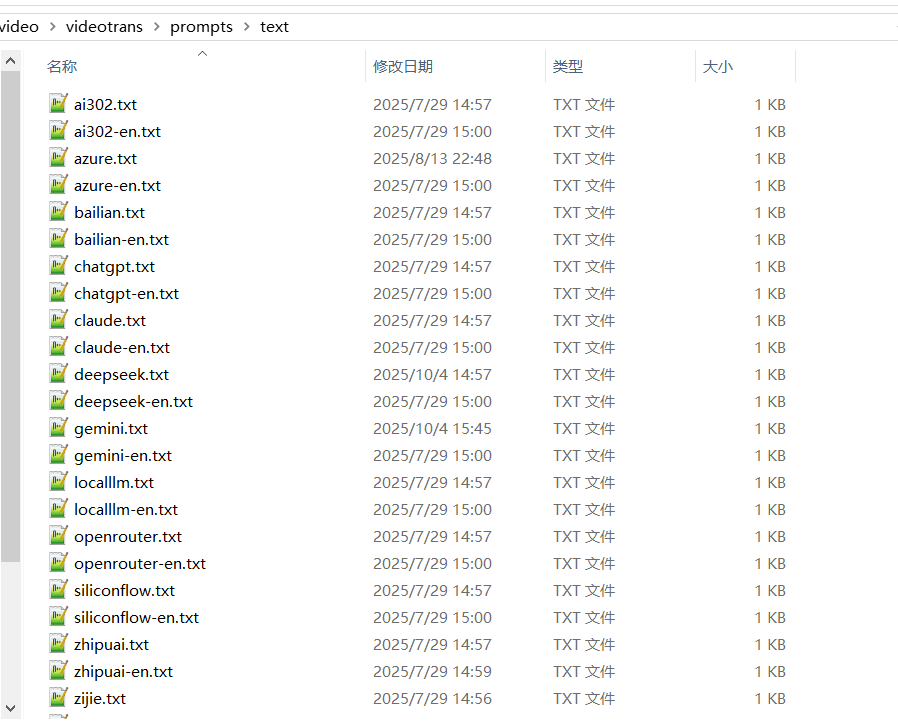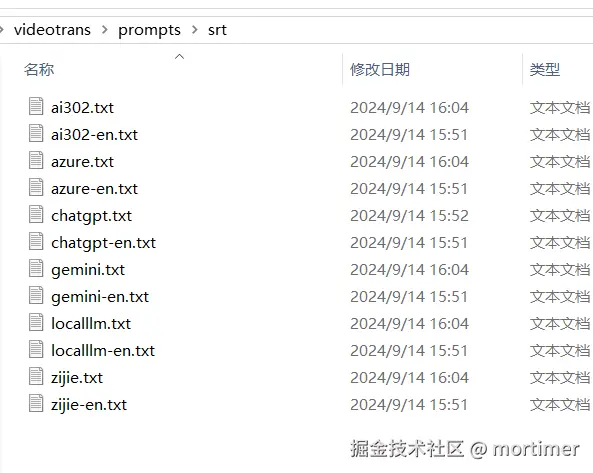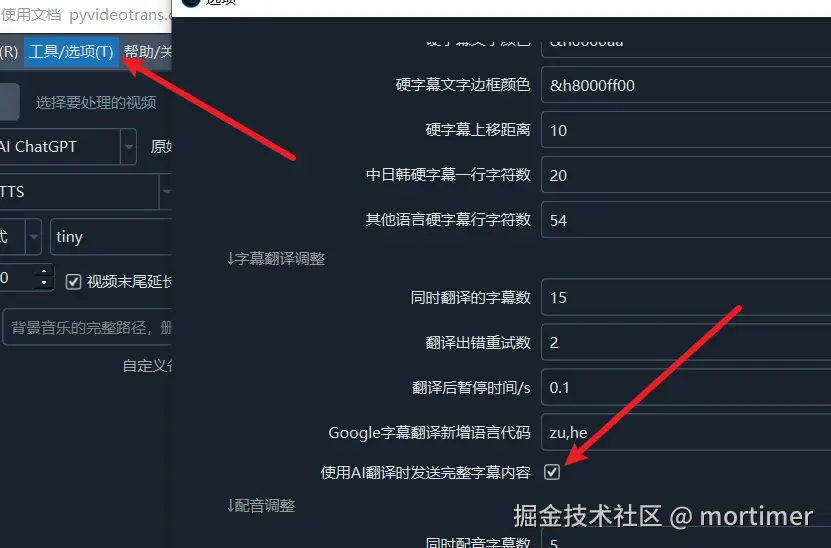修改 AI翻译提示词prompt
v2.52版本后新增了使用AI翻译时,发送完整srt字幕内容进行翻译的方式,而非之前仅仅发送字幕文字行按行翻译,以解决原始内容和翻译结果行数不对应问题。
显然翻译方式的不同,必然要求不同的提示词(prompt),之前按行翻译,着重限制AI务必返回同原文一致的行数,例如发送10行字幕文字,也必须返回10行字幕文字。
而新增的发送完整字幕翻译方式,着重限制AI必须返回合法的srt字幕格式。
因此需要两种不同的提示词(prompt)。
软件默认使用按行翻译方式
按行翻译的提示词位置在软件目录/videotrans/prompts/text 目录下,包括ai302.txt

若有需要可在此修改,只需修改不带-en的txt即可(-en.txt 后缀的是软件为英文界面使用的)。
默认提示词内容如下
请将<source>中的原文内容按字面意思翻译到{lang},然后只输出译文,不要添加任何说明或引导词。
**格式要求:**
- 按行翻译原文,并生成该行对应的译文,确保原文行和译文行中的每个单词相互对应。
- 有几行原文,必须生成几行译文。
**内容要求:**
- 翻译必须精简短小,避免长句。
- 如果原文无法翻译,请原样返回,不得添加“无意义语句或不可翻译”等任何提示语。
- 只输出译文即可,不要输出原文。
**执行细节:**
- 如果某行原文很短,在翻译后也仍然要保留该行,不得与上一行或下一行合并。
- 原文换行处字符相对应的译文字符也必须换行。
- 严格按照字面意思翻译,不要解释或回答原文内容。
**最终目标:**
- 提供格式与原文完全一致的高质量翻译结果。
<source>[TEXT]</source>
译文:修改时注意:
{lang}是目标语言名称,将在软件运行中根据所选目标语言动态替换,请勿删除<source>[TEXT]</source>这个也是在软件运行中会动态将[TEXT]替换为实际需要翻译的文本内容,禁止删除。例如动态替换后会变为<source>今天是个好日子,暴雨下到没马蹄</source>- 其他均可修改,但务必要限制AI必须直接返回译文,不要带有任何提示词或引导符,例如上面这句需要直接返回
It's a good day for a rainstorm that doesn't have hooves.,如果出现这类则会导致错误翻译结果如下:It's a good day for a rainstorm that doesn't have hooves.
发送完整srt字幕方式翻译
该翻译方式,会连带行号、时间行、字幕文字以合法的srt字幕格式,也期待AI会返回翻译后的合法srt字幕格式
默认提示词位置在软件目录/videotrans/prompts/srt目录下

同样只需修改不带-en的txt。默认提示词如下
请将<source>中的srt字幕格式内容翻译到{lang},然后只输出译文,不要添加任何说明或引导词:
注意以下要求:
1. **只翻译**字幕文本内容,不翻译字幕的行号和时间戳。
2. **必须保证**翻译后的译文格式为有效的 srt字幕。
3. **确保**翻译后的字幕数量和原始字幕完全一致,每一条字幕对应原始字幕中的一条。
4. **保持时间戳的原样**,只翻译幕文本内容。
5. 如果遇到无法翻译的情况,直接将原文本内容返回,不要报错,不要道歉。
以下是需要翻译的 srt 字幕内容:
<source>[TEXT]</source>
译文:修改同样要注意:{lang}是目标语言,不可删除或修改。<source>[TEXT]</source>同样不可修改删除,其他可修改,但务必要求AI直接返回同原文一样的合法srt格式译文,不可加提示词。
启用“发送完整srt字幕”方式翻译
菜单-工具/选项--高级选项--字幕翻译调整--使用AI翻译时发送完整字幕--选中。

增加术语表
每种提示词中均可添加自己的术语表,类似如下
**在翻译过程中,务必使用** 我提供的术语表进行术语的翻译,保持术语的一致性。具体术语表如下:
* Transformer -> Transformer
* Token -> Token
* LLM/Large Language Model -> 大语言模型
* Generative AI -> 生成式 AI
* One Health -> One Health
* Radiomics -> 影像组学
* OHHLEP -> OHHLEP
* STEM -> STEM
* SHAPE -> SHAPE
* Single-cell transcriptomics -> 单细胞转录组学
* Spatial transcriptomics -> 空间转录组学